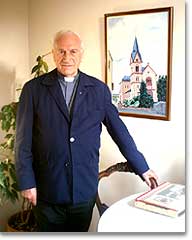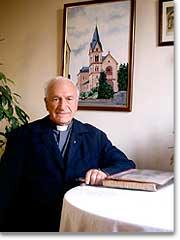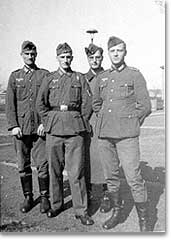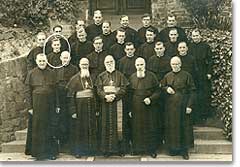 |
|
El Padre Alfonso, junto a una pintura de la Parroquia de Eisenbach, donde se bautizó, donde descubrió su vocación sacerdotal y donde celebró su primera Misa. Father Alfonso, close to a painting of the Parish of Eisenbach where he was baptized, where he discovered his vocation for the priesthood and where he celebrated his first Mass. Pater Alfons Boess vor einem Bild der Pfarrkirche in Eisenbach, wo er getauft wurde, seine Berufung entdeckte und seine Primiz feierte |
|
 |
|
P. Afonso Boess pertenece a la generación del „Ver Sacrum“ Father Afonso Boess is member of the generation of „Ver Sacrum“ Father Alfons Boess gehört zur Generation des “Ver Sacrum” |
|
 |
|
En pleno tiempo de guerra, vestido como soldado alemán, aparece el Padre Alfonso (el segundo de izquierda a derecha) junto a otros dos camaradas y Julio Steinkaul (el primero a la derecha) uno de sus compañeros de generación que entregó su vida heroicamente, cumpliendo el ideal de la primavera sagrada. In the midst of war, dressed as a German soldier, Father Alfonso appears in a photo (he is the second from left to right) along with two comrades and Julio Steinkaul (the first one on the right) one of his course brothers of his generation who gave his life heroically, fulfilling the ideal of the sacred springtime. Mitten im Krieg: in deutscher Soldatenuniform Pater Alfons Boess (2. v.l.) mit zwei Kameraden und Julius Steinkaul (re.), einem seiner Kursbrüder, der sein Leben gab im Sinn des Ver Sacrum |
|
 |
|
Después de diez años de guerra y prisión, el Padre Alfonso es ordenado sacerdote en Schoenstatt el 17 de junio de 1955, hace 50 años. After ten years of war and prison, Father Alfonso is ordained a priest in Schoenstatt on the 17th of June 1955, 50 years ago. Nach zehn Jahren Krieg und Kriegsgefangenschaft wird P. Boess am 17. Juni 1955 zum Priester geweiht Fotos: Boess/Vinculo Chile © 2005 |
|
|
CHILE, Maria de los Angeles Miranda B. Upon reaching 50 years of priesthood, most of it in Chile, Father Alfonso Boes reviews his novitiate during the war, his five years of prison in Russia and the heroism of those who gave their lives for Schoenstatt, as a "sacred springtime".
"It should be 60 years, because my road to the priesthood, the one our generation was generally very long". This how Father Alfonso Boes began to tell his history, a history tainted with love and suffering, for the fruitfulness of Schoenstatt, that was threatened by war and nourished by heroism.
1st of May of 1933. "May has arrived, the awakening of our people is completed!, Hitler said before two million workers, one day before the nazis occupied all the trade unions.
On this same day, in Schoenstatt, Father Alfonso was entering the Pallotine Minor Seminary, at the age of 14. Two weeks before, they had told him there was no room, that they already had 75 boarders, but one cancelled and he could enter. Of those 75 first postulants, he was the only one to be ordained as a priest; the selection process and then the war, left the others by the wayside.
Father Alfonso Boes was born in Eisenbach, Germany, on the 2nd of April of 1919, as the first son of Jakob and Elena, who later had seven more children. His sister Maria Alfonsia later entered the community of the Sisters of Mary.
During his childhood, his parents took him to Mass everyday before going to school, in which he also served as an altar boy. Once a religious asked him directly if he had a vocation for the priesthood and that was when he started to think about it. He entered the Pallotine Fathers through Father Alfons Hoffmann, from the first group of sodalists. And, his father’s cousin was Jose Schnieer, who was also one of the first, a close collaborator of Joseph Engling and who died in the First World War.
Those who are going to die greet you
In the seminary, the superiors already surmised that nazism would bring difficulties to Germany and for the Church, but the postulants still enjoyed the era of the full development of the Movement, of which they were active protagonists.
The spiritual fathers were Father Menningen, for the older ones and Father Bezler , for the younger ones. "And of course they took us to the Shrine at once and we learned about this first generation who had lived where we were just starting. This touched us very deeply. It took us to the goal we had set for ourselves especially during these years: "To guard their inheritance, we have to guard their inheritance."
While the first biographies of the heroic sodalists appeared, they began to know this founding generation, that offered its life in the First World War, such as Joseph Engling, Hans Wormer and Max Brunner. In 1934, the seminarians traveled to France to bring the remains of Hans Wormer and Max Brunner, which they buried next to the Shrine. "It was the first participation of the younger course and we even placed a big vellum poster with our signatures and the words "we will guard their inheritance" on the tombs. Since the remains of Josef Engling were not found, they traveled to CambraI in 1937 to erect a monument in the place of his death and they committed themselves with him to follow his example. "Father Kentenich considered Joseph Engling as the man who lived all the Schoenstatt message and the Covenant in the most exemplary manner." The motto among these young seminarians was "we have to be like him and from our generation there must be also be men like Joseph Engling".
The heroism of the first generation was especially inspiring for the seminarians because "already at this time it was surmised: maybe someday we will have to go through what they did, because World War II could also come", recalled Father Alfonson. In the year 1934, Father Kentenich told them "guard that inheritance and be like that generation that was fit to keep that commitment." In that way, Enrique Schafer and Julio Steinkaul, Father Alfonso’s course brothers, personally said: "I want to be the Joseph Engling of my course, for my generation". Afterwards, they also offered their lives during the Second World War. They were also impressed by Max Brunner. "Some of his words especially impressed us very much, which he exclaimed in the Shrine when he had to enter military service and he bid farewell from Schoenstatt, with four of his group, because they had been called to arms for the First World War, and faced a very uncertain future. He, with all enthusiasm, exclaimed before the Blessed Mother the words of the gladiators: "ave imperatrix, morituri te salutan", that is to say: "Ave Empress (the Blessed Mother), those of us disposed to die for You, greet you". It was an adaptation of the greeting the gladiators made to the Emperor of Rome before facing combat in the coliseum.
Camouflaging the ideals
Soon the time to show their love would arrive. Little by little the pressure from the national socialism began , that prohibited all religious work. "Be careful with the letters, with our magazines, in the year 1937, they pillaged one of our magazines that we would send to the other groups in the country and the Gestapo make contact with us. They wanted to detain the priests, but we would say: it is our doing, the priests had nothing to do with it, we do the editing and we write this", he said vividly.
They could still celebrate journeys in Schoenstatt, where youth from all over Germany arrived. "I recall the year of 1936, after the journey, Father Kentenich again gave us the final talk. (…)He used an expression that impressed me very much, and afterwards it accompanied me in all those difficult years that we lived far from our beloved place, when the nazis took us out of Schoenstatt, and then during the war. He spoke about the chosen ones and those who are sent - like youth - and at the end the words of Saint John: "you are not the ones who chose me, but I am the one who chose you, so that you can go out and bear fruit." The nazis closed the religious schools and the convents. In 1938, it was the Pallotine Seminary’s turn. By the first of March the house had to be turned over to the national socialist party and the school would be closed. They asked themselves, "what will happen now, what will be the future of Schoenstatt with the nazis beside the Shrine and in the house, what about our future, the priesthood, and in general the future of the youth in all of Germany. They had already taken everything into their hands and had prohibited all other influences on the youth".
Then, they looked for a common ideal. Since they could not express their ideals in common religious ideas, they had to camouflage them and they found the image of the Ver Sacrum, of the sacred springtime, taken from the history of ancient Rome according to Tito Livio, who relates that in times of poverty, the youngest of the town were offered to their God. "The youth that offers itself in sacrifice for the salvation of the people. The motto of Ver Sacrum is: for those of pure heart who sacrifice themselves, God will save all the people. This encouraged us very much", he said as if had been yesterday.
A novitiate during war
They were expelled from Schoenstatt and relocated in other schools to finish high school. "On the 31st of October of 1938 we placed a marble plaque on the monuments of the two (Hans Wormer and Max Brunner) at the side of the Shrine which read: "we will guard your inheritance", that was our commitment: we were expelled from here, but we were willing to guard the inheritance that was given to us by Joseph Engling and his companions. It has a big symbol of the paten with a flame: the oil by sacrificing itself gives light, that is what the Ver Sacrum is. The name of Joseph Engling is inscribed on it and today it found in all the Shrines". In fact, in each Shrine of the world the heroism of that generation shines in the light of the Blessed Sacrament, which is the symbol of the Ver Sacrum.
"In 1939, Father Kentenich solemnly crowned the Blessed Mother for the first time, saying: Blessed Mother take your work, your place in your hands, we are no longer capable, your place is in danger, we crown Queen in this situation".
The war broke out and with that "our road began to be mapped out", said Father Alfonso. The first seminarians were called to arms. He was able to finish high school and in February of 1940 he was called to combat.
How did you remain firm during the war?
-In the first place because of our attachment to the Shrine, to the Blessed Mother, with all confidence in Her, and conscious that when the time came, the sacrifice was to save the Work, to save Schoenstatt. For those of pure heart who offer themselves, God saves all the people.
In the meantime, the nazis had confiscated all our house, we no longer had a house, nor novitiate, then we started an external novitiate, a portable one. I was the first to receive the habit in the Shrine (24th of September 1941), at the beginning of the novitiate and, little by little, when one of us returned from vacations and passed by the Schoenstatt, he also received the habit (it took a year and a half before all of those in the course received it)., (…) And in this way we started a novitiate during the war, we didn’t know how long this situation would last. Our novitiate house was the Shrine, that was open.
We formed an epistolary contact in our groups, with our spiritual father, with our teacher of novices, who sent material for study. We did our novitiate as soldiers and only through epistolary contact.
How does a person on the road to priesthood feel when he has to go to war to kill?
- I never had to kill anyone, but this was only by luck. I did not shoot one bullet in the war. But Joseph Engling surely had to kill many because he was on the front lines of battle. Of course, it is a terrible situation.
It has another meaning, imagine we had to serve a criminal like Hitler, while he locked up our priests in the concentration camps, closing our houses, declaring our communities anti-patriots (…)We had to be soldiers for these people who were killing us from behind.
The war ended in May of 1945 and since January, I was in a concentration camp in Russia, as a prisoner of war, until the 24th of September of 1949, on the Feast of the Blessed Mother of Mercy. We did not know it was going to last so long, such a long time. For me this era lasted 10 years, it robbed ten years of my road to the priesthood, that is why I say I should be celebrating 60 years of priesthood and not 50. 5 years of war, 5 years as a prisoner in Russia.
What was the situation in prison?
- It was worse than the situation in war. More than half of us died of hunger, forced work, with much hunger, with a great lack of nourishment, we were only skeletons, that’s all. It was horrible.
I was young and although I was once in danger of dying and I was totally exhausted, I recuperated little by little. Diarrhea as usual. We drank coal from the furnace as a remedy and we ate any green thing that sprouted because the lack of nourishment was horrible.
How did you get out of the prison in Russia?
- Five years after the war ended, little by little, the Russians were internationally obligated to free its prisoners, slowly they began sending them back to Germany. First those who were not capable of working, but it still took several years.
Finally a priest
"As soon as I returned I started studying. My course brothers had returned at once after the war they were already priests".
I was ordained on the 17th of June 1955 en Schoenstatt. In June of 1956 I arrived to our country to work in the Parish of Carrascal. "When I arrived in Chile I did not know anything about the country, nor did I speak Spanish; I learned here little by little, he said.
In 1960 he departed to Germany returning in 1962, to the Parish of Saint Henry of Chimbarongo. In 1964 he arrived to Cerro Alegre in Valparaiso, the place the Movement was founded in Chile and in the year 1965 he was transferred to Vina. I have been there until now, helping - at the age of 86 - the Ladies Branch and serving the local German community, who also maintains a children’s home. He is also Chaplain of the Children’s Hospital and he always opens the door to all the poor who ask for Father Alfonso, giving them German clothes.
He keeps as a treasure all the relics: letters from Father Kentenich, the sketch of the symbol of the Ver Sacrum that Enrique Schafer sent him from the trenches, historic photos, also the history of Schoenstatt in Chile. As he himself says: he is determined that the Chileans, will also guard the inheritance.
Taken from: Vinculo, Magazine of the Schoenstatt Movement in Chile
Translation: Celina M. Garza, Harlingen, TX, USA